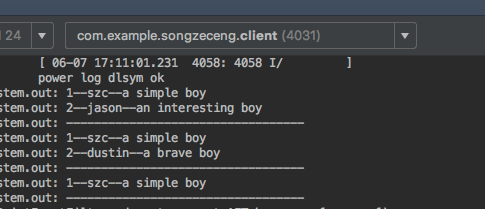安卓開發學習之ContentProvider的使用
阿新 • • 發佈:2019-02-14
背景
這幾天在學習安卓程序間通訊,而做為安卓四大元件之一的ContentProvider(內容提供者),也可以實現IPC。
現在記錄一下使用步驟
步驟
1、建立DatabaseOpenHelper
內容提供者的工作方式就和資料庫操作是一樣的,增刪改查,所以我們要先建立一個幫助類來建立資料庫,程式碼如下
public class MyDbHelper extends SQLiteOpenHelper { public static final String DB_NAME = "peopleDatabase.db"; public static final String TABLE_NAME = "person"; public static final int VERSION = 1; public MyDbHelper(Context context, String name, SQLiteDatabase.CursorFactory factory, int version) { this(context); } public MyDbHelper(Context context, String name, SQLiteDatabase.CursorFactory factory, int version, DatabaseErrorHandler errorHandler) { this(context); } public MyDbHelper(Context context) { super(context, DB_NAME, null, VERSION, null); } @Override public void onCreate(SQLiteDatabase db) { String sql = "create table if not exists " + TABLE_NAME + "(id int(3) not null, name varchar(20), description varchar(50), " + "constraint PK_PERSON primary key(id))"; db.execSQL(sql); } @Override public void onUpgrade(SQLiteDatabase db, int oldVersion, int newVersion) { } }
2、建立自己的內容提供者
程式碼如下
public class PersonProvider extends ContentProvider { private static final String TAG = "PersonProvider"; private static final UriMatcher MATCHER = new UriMatcher(UriMatcher.NO_MATCH); // uri匹配者 public static final String AUTH = "com.example.songzeceng.PersonProvider"; // 內容提供者的id public static final Uri PERSON_URI = Uri.parse("content://" + AUTH + "/person"); public static final String TYPE_MORE = "vnd.android.cursor.dir/person"; // 多條查詢的type public static final String TYPE_SINGAL = "vnd.android.cursor.item/person"; // 單條查詢的type public static final int CODE_SINGAL = 0; // 單條查詢的匹配碼 public static final int CODE_MORE = 1; // 多條查詢的匹配碼 public static String TABLE_NAME = "person"; private SQLiteDatabase mDatabase; private Context mContext; static { MATCHER.addURI(AUTH, "person", CODE_MORE); // 多條查詢 MATCHER.addURI(AUTH, "person/#", CODE_SINGAL); // 單條查詢,#是數字萬用字元,理解為id } @Override public boolean onCreate() { mContext = getContext(); mDatabase = new MyDbHelper(mContext).getWritableDatabase(); // 獲取可寫資料庫,可寫自然可讀 return false; } @Override public Cursor query(Uri uri, String[] projection, String selection, String[] selectionArgs, String sortOrder) { // 引數列表:表的uri、要查詢的列、where子句、where子句的引數、排序語句 System.out.println("query uri:"+uri.toString()); String type = getType(uri); if (isTypeValid(type)) { Cursor cursor = mDatabase.query(TABLE_NAME, projection, selection, selectionArgs, null, sortOrder, null); // 兩個null分別是groupBy和orderBy return cursor; // 返回的是遊標 } return null; } private boolean isTypeValid(String type) { return type != null && (TYPE_MORE.equals(type) || TYPE_SINGAL.equals(type)); } @Override public String getType(Uri uri) { int code = MATCHER.match(uri); switch (code) { case CODE_SINGAL: return TYPE_SINGAL; case CODE_MORE: return TYPE_MORE; } return null; } @Override public Uri insert(Uri uri, ContentValues values) { System.out.println("insert uri:"+uri.toString() + "--contentValues:"+values.toString()); if (isTypeValid(getType(uri))) { mDatabase.insert(TABLE_NAME, null, values); // null是nullColumnHack,用於插入空行(也就是ContentValues內容是空) mContext.getContentResolver().notifyChange(uri, null); // null是observer,觀察者 } return null; } @Override public int delete(Uri uri, String selection, String[] selectionArgs) { // 引數列表:uri、where子句、where引數 System.out.println("delete uri:"+uri.toString()); if (isTypeValid(getType(uri))) { int count = mDatabase.delete(TABLE_NAME, selection, selectionArgs); if (count > 0) { mContext.getContentResolver().notifyChange(uri ,null); } } return 0; } @Override public int update(Uri uri, ContentValues values, String selection, String[] selectionArgs) { System.out.println("update uri:"+uri.toString() + "--contentValues:"+values.toString()); if (isTypeValid(getType(uri))) { int count = mDatabase.update(TABLE_NAME, values, selection, selectionArgs); if (count > 0) { mContext.getContentResolver().notifyChange(uri, null); } } return 0; } }
可以看到,增加和更改的內容是放在ContentValues裡面,這個相當於一個雜湊對映
selection是where子句,selectionArgs則是引數,如果selection是"where id = ? and name = ? ",selectionArgs是[1,"szc"]的話,生成的完整的where子句就是"where id = 1 and name = \"szc\""
不過我直接把引數拼接到selection裡了,所以selectionArgs就成了擺設
另外增加方法的返回值是表的url,修改和刪除的返回值是影響的行數,感覺沒啥大用..
3、清單檔案中註冊
<provider android:name=".PersonProvider" <!--provider類名--> android:authorities="com.example.songzeceng.PersonProvider" <!--provider的id--> android:exported="true" <!--是否允許別的程序訪問--> android:grantUriPermissions="true" <!--是否允許解析uri--> android:process=":provider"> <!--provider所屬程序名--> </provider>
4、在客戶端進行CRUD檢驗
程式碼如下
public class MainActivity extends Activity {
public static final String TAG = "MainActivity";
private void insertData(Uri providerUrl, int id, String name, String description) {
ContentValues values = new ContentValues();
values.put("id", id); // 鍵值對
values.put("name", name);
values.put("description", description);
getContentResolver().insert(providerUrl, values); // 必須根據ContentResolver訪問內容提供者
}
private void updateData(Uri providerUrl, int id, String name, String description) {
ContentValues values = new ContentValues();
values.put("id", id);
values.put("name", name);
values.put("description", description);
getContentResolver().update(providerUrl, values, "id = " + id, null); // 第二個引數是where子句 ,null是where子句引數
}
private void deleteData(Uri providerUrl, int id) {
getContentResolver().delete(providerUrl, "id = " + id, null); // 第二個引數是where子句,null則是其引數
}
private void queryData(Uri providerUrl) {
Cursor cursor = getContentResolver().query(providerUrl, null, null, null, null); // 查詢所有記錄
while (cursor.moveToNext()) { // 只要遊標沒到底
int id = cursor.getInt(cursor.getColumnIndex("id")); // getColumnIndex()根據列名獲取列的位置,而後getInt()根據列的位置獲取列的值
String userName = cursor.getString(cursor.getColumnIndex("name"));
String description = cursor.getString(cursor.getColumnIndex("description"));
System.out.println(id + "--" + userName + "--" + description);
}
cursor.close(); // 莫忘記關遊標
System.out.println("----------------------------------");
}
@Override
protected void onCreate(Bundle savedInstanceState) {
super.onCreate(savedInstanceState);
setContentView(R.layout.activity_main);
try {
Uri providerUrl = PersonProvider.PERSON_URI;
insertData(providerUrl, 1, "szc", "a simple boy");
insertData(providerUrl, 2, "jason", "an interesting boy");
queryData(providerUrl);
updateData(providerUrl, 2, "dustin", "a brave boy");
queryData(providerUrl);
deleteData(providerUrl, 2);
queryData(providerUrl);
} catch (Exception e) {
e.printStackTrace();
}
}
5、檢視結果
客戶端截圖
服務(provider)端截圖
程序號不同,說明實現了程序間通訊
結語
受限於水平和精力,沒有怎麼鑽研內容提供者的原始碼,大致看了看原始碼和這篇文章,發現客戶端contentResolver的insert()方法最終呼叫了IContentProvider的insert()方法,而IContentProvider介面繼承了IInterface,似乎也是AIDL在幕後操縱,具體我就沒去看了


